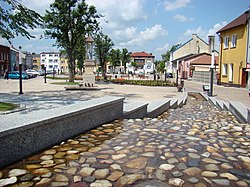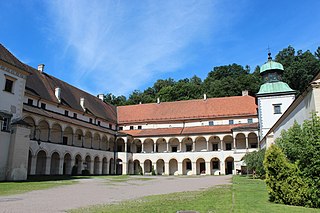
Sucha Beskidzka is a town in the Żywiec Beskids mountain range in southern Poland, on the Skawa river. It is the county seat of Sucha County. It has been in the Lesser Poland Voivodeship since 1999; previously it was in Bielsko-Biała Voivodeship (1975–1998).

Hrubieszów is a town in southeastern Poland, with a population of around 18,212 (2016). It is the capital of Hrubieszów County within the Lublin Voivodeship.
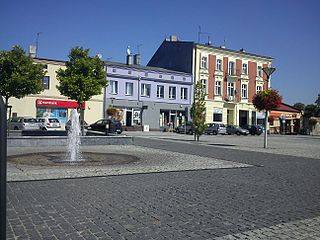
Czeladź is a town in Zagłębie Dąbrowskie, in southern Poland, near Katowice and Sosnowiec. Located in the Silesian Highlands, on the Brynica river, it is the oldest urban center of Zagłębie Dąbrowskie. The area of Czeladź is 16 km2, and it borders Będzin, Sosnowiec, Katowice and Siemianowice Śląskie.

Zawiercie ( ) is a town in southern Poland located in the Silesian Voivodeship with 49,334 inhabitants (2019). It is situated in the Kraków-Częstochowa Upland near the source of the Warta River. The town lies near the historical region of Silesia, but belongs to Lesser Poland.

Opole Lubelskie is a town in southeastern Poland. As of 2004, it had 8,879 inhabitants. The town is situated in Lublin Voivodeship, some 10 kilometers east of the Vistula River, and is the capital of Opole Lubelskie County. It was founded in the 14th century, and historically belongs to Lublin Land, which is part of Lesser Poland.

Kazimierz Dolny is a small historic town in eastern Poland, on the right (eastern) bank of the Vistula river in Puławy County, Lublin Voivodeship. Historically it belongs to Lesser Poland, and in the past it was one of the most important cities of the province.

Gąbin is a small town in Płock County, Masovian Voivodeship, Poland, with 4,065 inhabitants as of December 2021. The Warsaw radio mast, which stood near Gąbin, was the tallest structure in the world until its collapse in 1991. It remained the highest structure ever created till 2010.
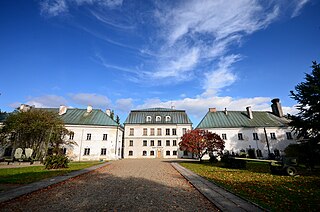
Dukla is a town and an eponymous municipality in southeastern Poland, in the Subcarpathian Voivodeship. As of December 2021, the town has a population of 2,017. The total area of the commune is 333.04 square kilometres (128.59 sq mi). Dukla belongs to Lesser Poland, and until the Partitions of Poland it was part of Biecz County, Kraków Voivodeship.

Bełżyce is a town in eastern Poland, in the Lublin Voivodeship, in Lublin County, and about 20 km (12 mi) to the west of the city of Lublin. Bełżyce belongs to the historical region of Lesser Poland. As of December 2021, the town has a population of 6,290.

Kock is a town in eastern Poland, about 45 kilometres north of Lublin and 120 kilometres south-east of Warsaw. It lies in Lublin Voivodeship, in Lubartów County. It is the capital of the administrative district Gmina Kock. Historically Kock belongs to the Polish province of Lesser Poland and is located in its northeastern corner. As of 2004, its population numbered 3,509.
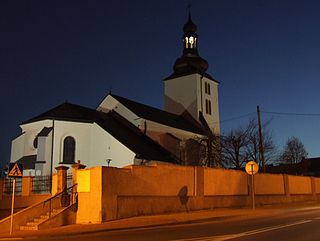
Lipsko is a town in eastern Poland, in northern Lesser Poland, Masovian Voivodeship. It is the capital of Lipsko County. The population is 5,895 (2004). Lipsko’s coat of arms is the Dębno, which was used by previous owners of the town.

Iłża is a small town in Masovian Voivodeship, Poland. In 2006 Iłża had approximately 5,165 inhabitants. The town belongs to the historical region of Lesser Poland, and from its foundation until 1795, it was part of Lesser Poland’s Sandomierz Voivodeship. Iłża lies in Małopolska Upland, on the Iłżanka river, 30 kilometers south of Radom.

Bychawa is a town in southeastern Poland, in Lublin Voivodeship, in Lublin County, about 25 km south of Lublin. The town lies in Lublin Upland and belongs to historic Lesser Poland. The town was first mentioned in historical documents from the 14th century and first received its city charter in 1537. The charter was lost in 1869, causing the town to revert to village status, but the charter was regained in 1958. In 1956–1975 Bychawa was the seat of Bychawa County. The town has the area of 6.69 square kilometres (2.58 sq mi), and as of December 2021 it has 4,757 inhabitants.
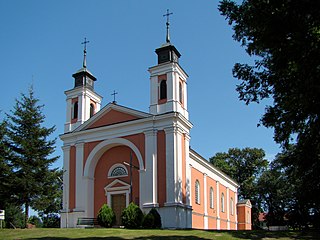
Tyszowce is a town in Tomaszów Lubelski County, Lublin Voivodeship, Poland, with 359 inhabitants (2004). Tyszowce was incorporated as a town from 1419 until 1870 when it lost its city charter, to regain it only in 2000. In 1655 the Tyszowce Confederation was formed here.

Bodzentyn is a town in Kielce County, Świętokrzyskie Voivodeship, Poland, with 2,168 inhabitants as of December 2021. Bodzentyn belongs to Lesser Poland, and was granted town charter in 1355. The town lies in the Świętokrzyskie Mountains, here main office of the Świętokrzyski National Park is located.
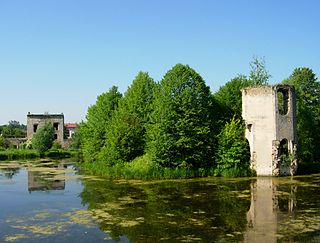
Ćmielów is a town in Ostrowiec County, Świętokrzyskie Voivodeship, Poland, seat of Gmina Ćmielów. As of December 2021, it has 2,954 inhabitants. It is known for one of Poland's oldest porcelain factories dating back to 1790. The town history dates back to 14th century. It has several tourist attractions, in addition to its old porcelain factory, including ruins of a 16th-century castle and a church from the same period. Ćmielów belongs to Lesser Poland, and lies on the Kamienna river in the Sandomierz Upland, 10 kilometers east of Ostrowiec Świętokrzyski, along local road nr. 755.

Chęciny is a town in Kielce County, Świętokrzyskie Voivodeship, southern Poland, with 4,361 inhabitants as of December 2021. It was first mentioned in historical documents from 1275, and obtained its city charter in 1325. At that time was one of major urban centers of northern Lesser Poland.

Działoszyce is a town in Świętokrzyskie Voivodeship, Poland, with 2882 inhabitants as of December 2023.

Sokołów Małopolski is a town in Rzeszów County, Subcarpathian Voivodeship, Poland, with a population of 3,962 (2 June 2009).

Złoczew is a town in Sieradz County, Łódź Voivodeship, Poland, with 3,340 inhabitants (2020). The city is 23 kilometres south of Sieradz and 23 kilometres north of Wieluń.
